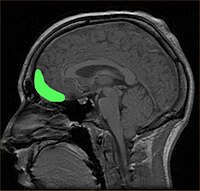
Photo from wikipedia
The stop signal task (SST) is the gold standard experimental model of inhibitory control. However, neither SST condition–contrast (stop vs. go, successful vs. failed stop) purely operationalizes inhibition. Because stop… Click to show full abstract
The stop signal task (SST) is the gold standard experimental model of inhibitory control. However, neither SST condition–contrast (stop vs. go, successful vs. failed stop) purely operationalizes inhibition. Because stop trials include a second, infrequent signal, the stop versus go contrast confounds inhibition with attentional and stimulus processing demands. While this confound is controlled for in the successful versus failed stop contrast, the go process is systematically faster on failed stop trials, contaminating the contrast with a different noninhibitory confound. Here, we present an SST variant to address both confounds and evaluate putative neural indices of inhibition with these influences removed. In our variant, stop signals occurred on every trial, equating the noninhibitory demands of the stop versus go contrast. To entice participants to respond despite the impending stop signals, responses produced before stop signals were rewarded. This also reversed the go process bias that typically affects the successful versus failed stop contrast. We recorded scalp electroencephalography in this new version of the task (as well as a standard version of the SST with infrequent stop signal) and found that, even under these conditions, the properties of the frontocentral stop signal P3 ERP remained consistent with the race model. Specifically, in both tasks, the amplitude of the P3 was increased on stop versus go trials. Moreover, the onset of this P3 occurred earlier for successful compared with failed stop trials in both tasks, consistent with the proposal of the race model that an earlier start of the inhibition process will increase stopping success. Therefore, the frontocentral stop signal P3 represents a neural process whose properties are in line with the predictions of the race model of motor inhibition, even when the SST's confounds are controlled.
Journal Title: Journal of Cognitive Neuroscience
Year Published: 2019
Link to full text (if available)
Share on Social Media: Sign Up to like & get
recommendations!